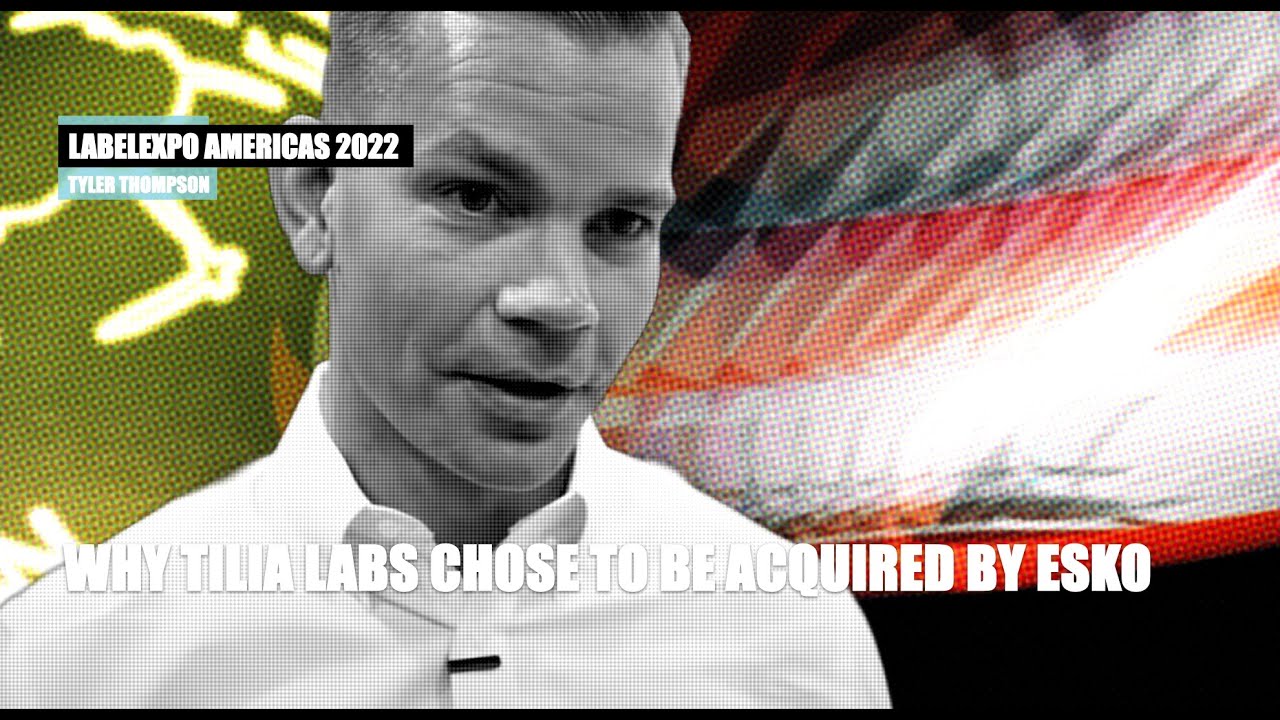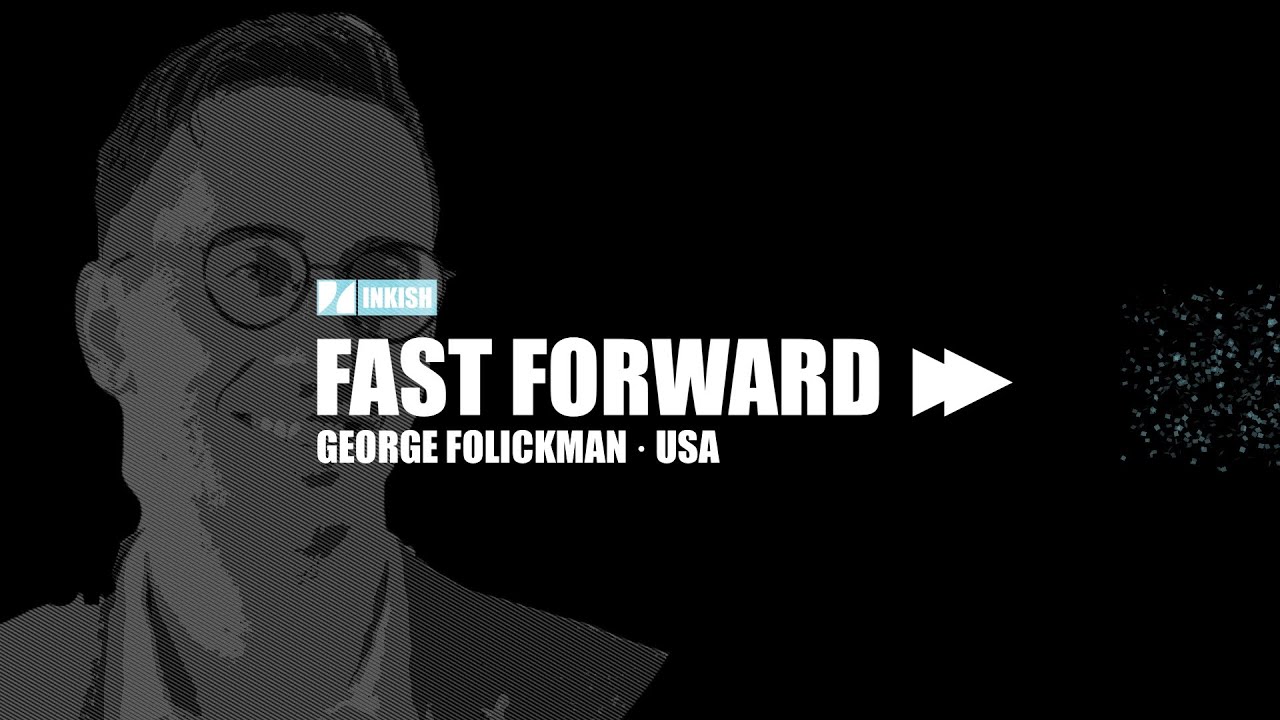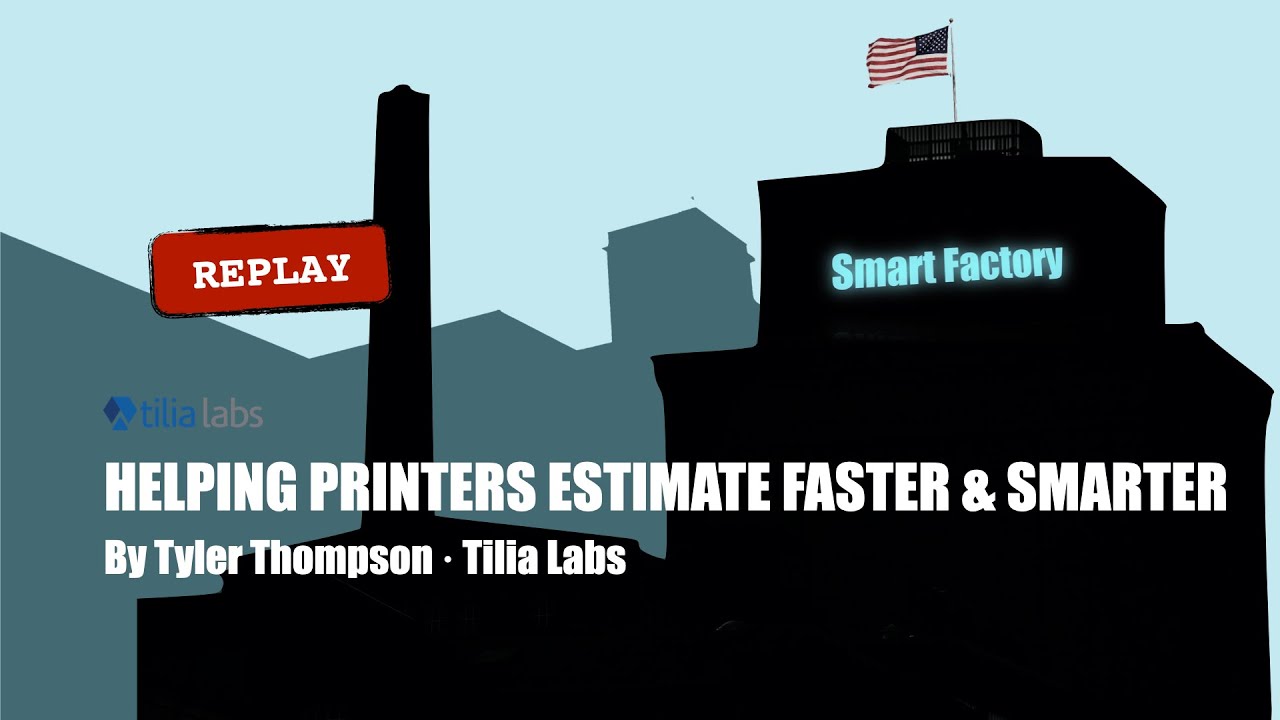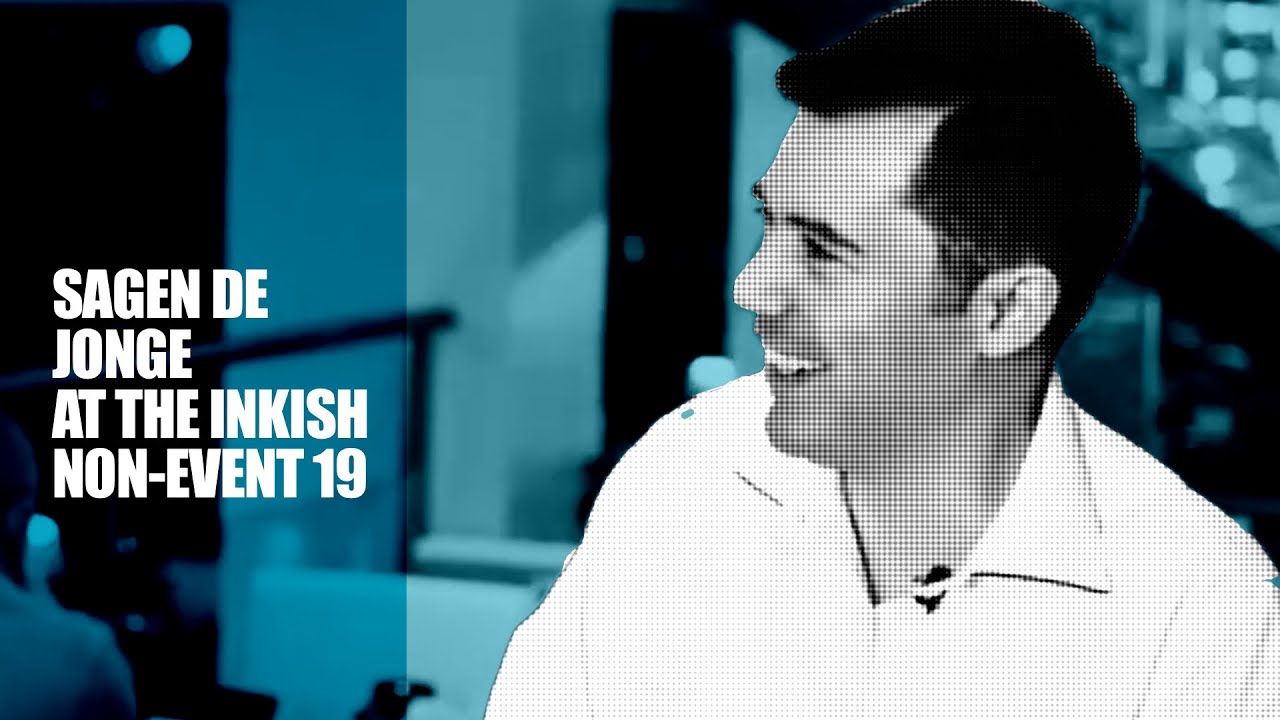Sagen De Jonge · Over The Skype · Tilia Labs
In this ‘Over the Skype’ session, I have the pleasure of talking to Sagen De Jonge from Tilia Labs. Tilia Labs have, in few years, got a lot of recognition from the market for their imposition/planning tool Phoenix. In this session, we talk about AI, API, and how Phoenix help printing companies to become more efficient.
As with all our ‘Over the Skype’ interviews, quality is limited to bandwidth, web-cams, and ability to literally LIVE mix the conversations. However, it works, and with Over the Skype, we will bring you more than 20 exciting people, and angles on the industry as it is right now.
Enjoy!
This is Morten from INKISH TV and this is another episode of All the Skype, where this time we are in Toronto in Canada and I’m going to talk to one of my very dear friend, Sagen De Jonge from Tilia Labs. Welcome to my show, Sagen. How are you?
Thanks Morten. Doing well. Thanks for having me today.
So Sagen, I thought that last time I met you, that was in Japan. So why are you in Toronto right now?
Well, Toronto is where I live. Japan, I was traveling there at the time. Right now we can’t go anywhere like everybody else I think. So, that’s where I am.
I was just trying to get you to say that you are one of the most global companies in the printing industry with floating offices and people all over the world. But you didn’t take the bite.
Okay, yeah. Well, that’s true. We do operate remotely, so we have people in Japan, the US, Europe and we’re traveling all the time.
When we met each other a couple of years ago, you were actually, you were you and Scott of course, and then you had, I think you had one person in the US and today you are a considerably big company because you are doing really good. Before we talk about how you’re doing, maybe you can explain a little bit what is Tilia Labs and what is it that makes you different from the rest of the bunch?
Sure. So Tilia Labs is a software company and we focus, our methodology is agile so we try and iterate quickly and we are really interested in innovating. Some pretty key things we are working on is things like AI technology to optimize production. We’re really particularly focused on the workflow aspect, optimizing, production, imposition, improving efficiency for customers.
I’m sorry to, I don’t know if I interrupted you, but I think that we have to step a little bit what’s the back because I know what you do and a lot of people know what you do right now. But I think that we should go a little bit more to details because basically you have maybe done some of the smartest automation in the industry when it comes to imposition and planning. So before we go into some of the more detailed aspects with the artificial intelligence and those aspects, what challenges did you and Scott see when you started Tilia Labs and how did you get into what you’re doing today?
For sure. When Scott and I got started, we saw a number of challenges. The first thing that really, really got us interested is we thought there was a lot of room to modernize in the printing industry. We saw some of the software out there and there are some great technologies, but we felt that there was a lot of room to modernize and bring a new spin to things. We got started in packaging with imposition and we very quickly saw that not only can we modernize, make a better user experience, but there was a lot of room to actually improve optimization as well. So we started working on what we called our planning technology to plan different jobs together really quickly, really efficiently.
Then we started branching out from there because the next thing we saw is that not only do we think there’s room to modernize, there wasn’t a good solution that could do everything. Packaging printers had one software, wide format printers had another, commercial printers had another. The thing that we saw a lot of people struggling with is as the market was changing, a lot of printers had to do more different kinds of work. So a commercial printer is now doing packaging and vice versa. So it’s really difficult to use all these different softwares. So it became our new goal as well.
That seemed like that was a very good opportunity for Tilia Labs because not only have you been quite successful, I must say, but you have also, I think that one of the things that I pay attention to when I listen to you and Scott and also when I see you at various trade shows is, one thing is that you identified the planning and it could be in one solution. But you also very soon realized that a lot of the applications out in the market were using template based imposition requiring a lot of pre-press time before you could actually utilize the imposition. So you took a different approach to how imposition should be done, right?
Yeah, absolutely. That’s really where our planning and AI technology comes into play. I think traditionally most solutions use templates and it’s a very good solution. But the problem is if you’re dealing with so many different kinds of jobs and runs are getting shorter, all kinds of different sizes, you need thousands and thousands of templates and every day maybe you’re adding a new template. And that just becomes really difficult to manage. So our approach was to just say, okay, just tell us what you want to print and we’re going to figure out automatically how to lay it out. You don’t need a template. We know the production equipment, we know enough about your production that we can do it in a way that’s actually feasible to go and produce it because that’s a difficult problem to actually not use a template, but figure out the right kind of margins, et cetera, how to lay it out properly.
Sometimes I think that you’re a little bit too humble because I know that you and Scott have put a lot of time and effort and money into both understanding the market and the needs in the market. But basically when we talk about the number of templates just to manage that, that is of course one thing. But isn’t it, and that’s leading, but isn’t it also a fact that the more templates you have just to remember them and organize them and utilize them is an issue that printing companies see daily. Saying that, you end up in a situation where doing the templates is extremely time consuming also because with the mass customization and shorter print runs, everything grows exponentially, right?
Yeah, absolutely. The management of those templates, if you’re an operator just manually using a solution, then you’ve got to go and choose that template. And if you’ve got thousands, that can become difficult. But even if you’re automating, then you have to figure out an automated way to decide which template to use. And that’s another difficult problem. By not requiring using templates, we can get around a whole slew of problems. But also, we actually go a step further because there are certain things where you absolutely, you need, it’s not a template per se. A good example is folding cartons. You’re going to make a dye to actually cut it out of the end. And that dye, that’s a template essentially. You need to match that dye exactly when you’re printing that.
So we recognize that there are scenarios where we absolutely have to lay things out in a certain way, but we also took a bit of a different approach there. Where instead of saying, okay, you go and choose a template for that. You just tell us the folding carton you’re going to print and we’ll search through your entire dye library and just find the right one. Or if there’s multiple, we’ll give you the selection. Say, which one do you want to use? So you don’t have to go and take this manual approach to find it yourself.
Okay, so let’s say that you are a printing company, maybe being in the packaging, folding carton, packaging your business for eight years and you have maybe hundreds of thousands of physical dyes in your warehouse. What you’re saying is basically that you can even help printing companies to find existing tools easily?
Yep, absolutely. Utilize your existing tools, catalog them in our software and then we’ll automatically do a shape search and go find the right one to use.
And I guess that you would even be able to, let’s say that the printing company gets new formats of paper and print and you will probably be able to calculate whether it’s most feasible to make a new dye or continue with existing dye, right?
Yep. That’s absolutely right. This is where the AI part comes into it because well, what our software is doing when we’re looking at all of these things is figuring out the best approach. And there are so many different variables. For example, you could have dyes or you could decide to run it on a digital cutter or you could be running it on one stock side versus another enough, you could have five different presses. So we look at these hundreds of different types of variables and then you’ve got, all of a sudden you have millions, billions, infinite number of combinations how you can do this. You can approach that problem by just saying, okay, let’s just compute every combination. It’s impossible. You could try and compute to the end of time. You wouldn’t be able to compute them all. So we have to take a heuristic approach and that’s where an AI based algorithm really, really helps because you need to actually make decisions, smart decisions on what’s the best approach to pick to get to a good result quickly.
I like that approach a lot and you know that. That doesn’t come like a big surprise to you, I’d say. However, one of the things I maybe think we should discuss a little bit because I think that AI or artificial intelligence has become a buzzword. You see it in many different places and application, not only in our industry but everywhere. So before we continue talking about the products and what you’re offering, can you explain in simple words, what is artificial intelligence?
Artificial intelligence is a number of different things. It’s different various sets of algorithms. You’ve got machine learning for example. That’s a pretty typical one. There’s various different approaches to it. So in our case, we use a number of different algorithms. In fact, we’re going to actually be doing a presentation. We were going to be presenting at [Taigo 00:10:21] on the various techniques that we’re taking with AI. That was postponed, but they’re doing an online presentation. I think that’s going to be happening next week. So we’ll go into more detail about that. But basically maybe a simple way to think about it where you might have a rule based approach to finding a solution, AI algorithms will employ different techniques to actually find a solution with some smarts in there.
Okay. If a should conclude on the purpose of AI, that is basically that with artificial intelligence or AI, you enable the software to take decisions and learn from it and make sure that it comes out with some results that are faster and better because the decisions are not just like, of course never a random pick, but you know what I mean? So it’s more like it is capable of making choices based on the input it gets.
Yeah. Just making intelligent decisions. Those decisions in many ways we’re trying to mimic decisions that humans would make. People are really good at solving problems, but the issue with the problem we’re dealing with is so huge. If you give someone this problem of optimizing a job for print production, there are so many variables that they would probably need a full week to try a lot of different things and still, they’re not going to be able to compute everything. So our algorithms computers are really good at dealing with a lot of data really quickly. And then on top of that, we’re building an intelligence to make decisions, make similar kinds of decisions that [inaudible 00:12:07] would make, but it’s even smarter as we get more data and do it more quickly.
Okay. So, smarter and better and faster, some of the keywords in what the Tilia Labs is offering your customers. When it comes to the position, you also have the nesting part of that, I think that, we’d been talking to both you and Scott, I think that often we also talked about that with, for example, in large format where you have sometimes very expensive material. The actual payback time for investing in the Tilia Labs software is down sometimes to few weeks because of the efficiency that you can utilize from an expensive substrate. Is that something that you see from only new one customer or is that something that you see generically?
Yeah, we see it very often, but there’s been special cases. I think one of the cases we talked about with you was a customer we had during the trial period. It paid for the software because of the substrate they’re using. They saved thousands of dollars on a single job and that paid for the software. That’s not the most typical case, but it’s definitely every customer we’re going into, we’re offering them planning and our AI technology to optimize for them. Material savings is something we see across the board. So material savings, time savings, and especially in wide format where we do run into these expensive materials quite often, that can have a big impact.
So you wouldn’t say that it’s not because of the material cost. You will do that unless you do something on very expensive substrates frequently. But it’s just part of the solution is that you have the… It has to be something that you take into the equation anyway. So let’s move on to another thing that I also know that you have got very good critics for from users is that you have a very comprehensive API in your solutions in Phoenix. First, can you just explain very briefly what an API is and then secondly, explain why that is important to a printing company?
Sure. An API is a way of communicating with a software so that you can set up things in an automated environment. Typically, you’ll have something like a server where you expose it, you expose your own and then you can talk with that server and have it perform some kind of work. In our software we’ve had an API for since very early on and that was all part of one of our key goals, which was to modernize. We want to modernize the user experience, but we also felt from day one, more and more today there are developers in-house and printers and people are implementing their own customized solutions and having API is just the starting point there. There’s different approaches. You could, for example, [inaudible 00:15:22] approach. But that’s a lot more restrictive if you have an API all of a sudden for developers just like, okay, the sky’s the limit now and it makes everything a lot more powerful, a lot more easy. It’s just a much smarter way of doing things.
I take that maybe you said that indirectly, but I think that with for example, some of the larger printing companies, especially those printing companies who have IT resources employed, they are large because they have large volume and they have specialized jobs and they have a vast number of operations that can be optimized and automated. So with API, these companies are able to take your features of the software that you would normally click on this button and normally you will drag this to this place and normally you will ask it to do something like that. You can basically automate that so that becomes part of the entire workflow process. So everything will be 100% automated, even using your core technologies, right?
Yeah, that’s right. You could essentially think of it exactly you described where you’re doing a manual set of tasks. You have these tasks, those are operations you’re going to do. Now instead of a person clicking those buttons, you can make an API call for each one of those and you can set that up. So it’s just now that’s just going to happen automatically. Every time a file comes in, it runs through those set of tasks [inaudible 00:16:52].
I think that these first 17 minutes we’ve been talking have given hopefully the viewers an insight in why Phoenix and Tilia Labs is on the top of the curve when it comes to developing a software that is used all the time and a printing company and that has a very high value because it can do all these things automated. So if we look at from a business perspective, first question is of course that when you look at imposition tools, I think that sometimes you do get imposition tools as, what does it cost per license? Or how many users do I have in my pre-press department and do I need to have one for each of my pre-pass people and think of that? But that is not entirely correct or true when it comes to how you would evaluate the cost of Phoenix, is it?
No. Yeah, that’s true. It can be pretty complex to evaluate the cost because we’re trying to optimize the production. But the really interesting thing, people often ask us, I want to buy this software. Do you have an ROI calculator? And the answer is absolutely, yes. That is that our solution Phoenix is the ROI calculator because we can do a trial and you can put in all your costs, your materials, your production equipment, et cetera, and then it’s going to calculate the costs. So you can now see, okay, what was my costs been before? What would’ve my time been before? So you actually have your ROI there. Based on that, we’re going to tell you the price of the software. Based on that, you can calculate your ROI on it. So yeah, that’s the way it works.
But I was more thinking of that, if you have a template-based precision system, you would probably need one for every pre-press person you have. But since you can automate a bunch of things automated using hot folders and using the flows of your current workflows, you may not need as many licenses as if you compare it to something else. Right?
Yeah, absolutely. Traditionally, if you’re going to have people manually using the software versus the automated, you might need one copy that might do all of your work. Another thing we do, our licensing model is fairly flexible. We have the traditional perpetual license where you just buy it. But we also have, if you don’t want to make a big investment, you can start out with a subscription. And then we also have, we call a cloud licensing where you can use Tilia Cloud and you can actually license the software across different locations and share licenses.
That is something that is recently new, reasonable new, isn’t it? I think that when I met you and Scott in Japan two, three months ago, that was just starting at that time, wasn’t it?
Yes, that’s right. We released that, I think April last year.
April last year. Okay, yeah. I was a little bit wrong with that, but I understand that. So basically what you’re saying when it comes to the cost of owning or using Phoenix is basically that you have different models so it can fit both large printing companies and smaller printing companies, right?
Yep, absolutely. And that’s what we have. We have a really diverse range of customers. We have customers in every segment, packaging labels, commercial life format. But we also have customers, we have customers that are, there’s five people at the company and customers that are huge billion dollar companies. So it’s a really diverse set.
Now we spoke about it from a customer’s perspective. One of the things you mentioned in the beginning was that you wanted to make one solution that could accommodate the need for both packaging labels, commercial printing. I guess that that objective you have reached, right?
Yes. Sorry Morten. I’m just going to close down this. Here we go. Slack just keeps making noise here.
If I was doing like this before, it was because my kids were coming shouting, “I’m going to bake a cake, pap. I’m going to bake a cake.” “Yeah, you go bake a cake. But keep quiet please. Dad is working.” I know what you’re saying. But Slack seems more serious than my kid wanting to bake a chocolate cake.
Well, the thing is though, it’s not supposed to bother you, but it seems to anyway. It still makes a noise.
Okay. Sorry for that. Oh, that’s okay. So you have accommodated one of your objectives from the beginning to have one solution that can cover a lot of things, right?
Absolutely, yeah. With our most recent lease, we’ve gotten very close to just being able to handle everything really. We had a really strong hold on packaging since the beginning. Then wide format, we’ve gotten very mature there. Labels are very mature, commercials, the newest area for us. But we’re making huge strides in there and we can pretty well handle any kind of job [inaudible 00:21:57].
So, how is it going with Tilia Labs as a company? Because you mentioned in the beginning that you, as far as I know, you have grown rapidly since the first time we met each other couple of years ago and you have several people working for you right now. So what is the market situation for you guys? Are you still growing like the, I don’t know what to say, but skyrocketing?
Yeah, it has been very good. Since we saw you in Japan, the trend had continued and so we’re growing, we’re predicting double growth this year, which was about what we did last year too and the years before that. So the trend has been great and we know there’s a lot of markets still that we actually haven’t penetrated that much. So we see a lot more opportunity. That being said, I think we’re in a really similar boat to everybody else right now. The impacts of COVID-19, we’ve really felt that too. I think in our case, we’re a software company so we’re a bit lucky, a core part of our business, our development that hasn’t changed that much. We were remote from day one so that’s fine. But there’s other aspects that are greatly impacted by it.
Yeah. Because I think that one of the things that you did when you employed people in the US, I think they were traveling quite a lot also because sometimes I think that seeing is believing. And also the trade shows I guess has been good lead generators for Tilia Labs.
Yeah, absolutely. That’s the part that has been effected, part of our business has been affected the most because most of our guys in the US are traveling most days of the week. That’s for sales, but it’s also for things like training, implementations. That’s all stopped. We’re still training customers and doing various things, but our customers are in a very different situation too. We have some customers that production has completely closed down. Some customers where, we have one customer in the US where the production just skyrocketed so much. Others they’re in packaging, that they don’t have any time. Of course, they’re just so busy trying to get the work done. So it’s a pretty unique situation.
How annoying? Either they don’t have time because they’re too busy or they have too little work to invest. That must be a very unfortunate situation for you guys.
Yeah, it’s tough. It’s tough, but we can’t complain. It’s a hard situation for everybody and we’re trying to get by as best we can, but also help our customers too. Our customers, they’re innovating in all kinds of ways. It’s pretty interesting to see what they’re doing as well.
I think that one of the things that I have also noticed in the years I have known who is that, I guess it’s sometimes you are a little bit surprised how creative also your customers are in actually utilizing what you have been developing. Right?
Yeah, yeah. We found that really interesting. All of a sudden you see a new way that someone’s using something. You didn’t think of that, but it’s really, it’s inspiring. When your software gets to a point where you know it can do things that you didn’t know it can do, that’s really nice. Really interesting.
Sounds great. Second, I guess that you’re busy as usual, so I will not take more of your time. Just on final note here, I just want to say again, I’ve mentioned this before, I really appreciate that I know both you and Scott. We have mentioned Scott several times. He is basically your CTO and you are the CEO of Tilia Labs. We didn’t mention that. But when we met each other first time in Chanhassen, at the Bernard Group, I think that led into a good friendship and I owe to you that we have Diego [inaudible 00:00:25:59], the king of workflow on INKISH news. So I think that is pretty awesome that we’ve got to know each other that way around. I also want to thank you very much both for attending the [inaudible 00:26:11] event in Copenhagen. I think it was awesome that both of you decided to travel all the way to Copenhagen for that event. So again, thank you very much for all the support during the years and I wish you all the best in the future. And thank you for joining me here on All the Skype.
Absolutely, Morten. That’s 100% mutual.
Thank you very much.
Thank you.
Thank you.








































































